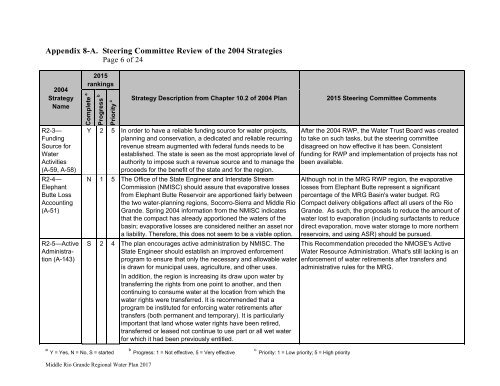Middle Rio Grande Regional Water Plan
2iUWd5b
2iUWd5b
Create successful ePaper yourself
Turn your PDF publications into a flip-book with our unique Google optimized e-Paper software.
Appendix 8-A. Steering Committee Review of the 2004 Strategies<br />
Page 6 of 24<br />
2004<br />
Strategy<br />
Name<br />
R2-3—<br />
Funding<br />
Source for<br />
<strong>Water</strong><br />
Activities<br />
(A-59, A-58)<br />
R2-4—<br />
Elephant<br />
Butte Loss<br />
Accounting<br />
(A-51)<br />
R2-5—Active<br />
Administration<br />
(A-143)<br />
2015<br />
rankings<br />
Complete a<br />
Progress b<br />
Priority c<br />
Strategy Description from Chapter 10.2 of 2004 <strong>Plan</strong><br />
Y 2 5 In order to have a reliable funding source for water projects,<br />
planning and conservation, a dedicated and reliable recurring<br />
revenue stream augmented with federal funds needs to be<br />
established. The state is seen as the most appropriate level of<br />
authority to impose such a revenue source and to manage the<br />
proceeds for the benefit of the state and for the region.<br />
N 1 5 The Office of the State Engineer and Interstate Stream<br />
Commission (NMISC) should assure that evaporative losses<br />
from Elephant Butte Reservoir are apportioned fairly between<br />
the two water-planning regions, Socorro-Sierra and <strong>Middle</strong> <strong>Rio</strong><br />
<strong>Grande</strong>. Spring 2004 information from the NMISC indicates<br />
that the compact has already apportioned the waters of the<br />
basin; evaporative losses are considered neither an asset nor<br />
a liability. Therefore, this does not seem to be a viable option.<br />
S 2 4 The plan encourages active administration by NMISC. The<br />
State Engineer should establish an improved enforcement<br />
program to ensure that only the necessary and allowable water<br />
is drawn for municipal uses, agriculture, and other uses.<br />
In addition, the region is increasing its draw upon water by<br />
transferring the rights from one point to another, and then<br />
continuing to consume water at the location from which the<br />
water rights were transferred. It is recommended that a<br />
program be instituted for enforcing water retirements after<br />
transfers (both permanent and temporary). It is particularly<br />
important that land whose water rights have been retired,<br />
transferred or leased not continue to use part or all wet water<br />
for which it had been previously entitled.<br />
2015 Steering Committee Comments<br />
After the 2004 RWP, the <strong>Water</strong> Trust Board was created<br />
to take on such tasks, but the steering committee<br />
disagreed on how effective it has been. Consistent<br />
funding for RWP and implementation of projects has not<br />
been available.<br />
Although not in the MRG RWP region, the evaporative<br />
losses from Elephant Butte represent a significant<br />
percentage of the MRG Basin's water budget. RG<br />
Compact delivery obligations affect all users of the <strong>Rio</strong><br />
<strong>Grande</strong>. As such, the proposals to reduce the amount of<br />
water lost to evaporation (including surfactants to reduce<br />
direct evaporation, move water storage to more northern<br />
reservoirs, and using ASR) should be pursued.<br />
This Recommendation preceded the NMOSE's Active<br />
<strong>Water</strong> Resource Administration. What's still lacking is an<br />
enforcement of water retirements after transfers and<br />
administrative rules for the MRG.<br />
a Y = Yes, N = No, S = started<br />
b Progress: 1 = Not effective, 5 = Very effective<br />
c Priority: 1 = Low priority; 5 = High priority<br />
<strong>Middle</strong> <strong>Rio</strong> <strong>Grande</strong> <strong>Regional</strong> <strong>Water</strong> <strong>Plan</strong> 2017


